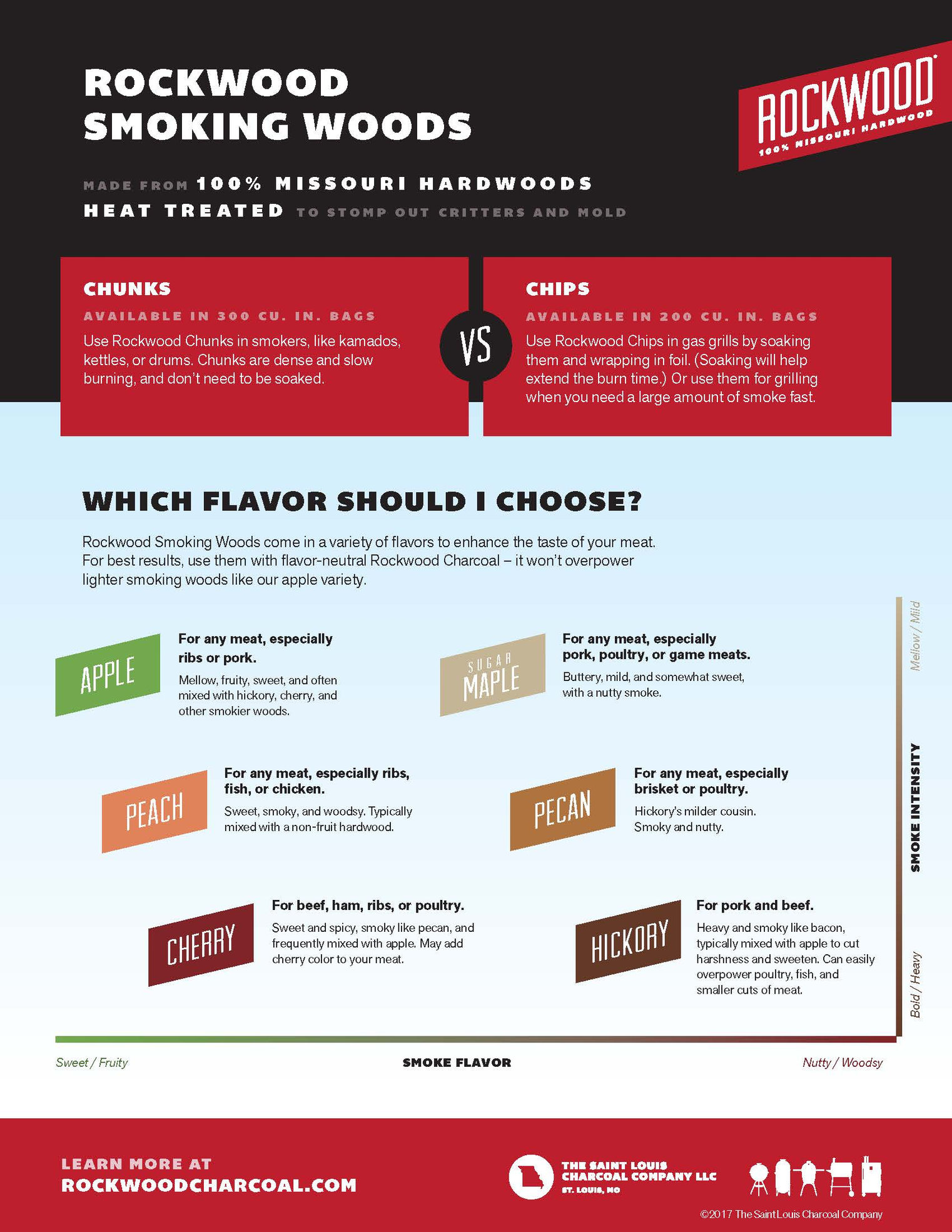Share your photos by tagging us and using the hashtag #BigGreenEgg.
Want to see how the EGG is made? Click to Watch
Soaked or dry wood chips?
Comments
-
No soak. Read the Meathead article.
https://amazingribs.com/more-technique-and-science/more-cooking-science/myth-soak-your-wood-first
-
Don’t soak!
Post oak for beef, apple wood for pork, cherry mixed in from time to time for color."I've made a note never to piss you two off." - Stike
"The truth is, these are not very bright guys, and things got out of hand." - Deep Throat -
...Oh... and hickory is my fave!
-
Only use chunks in egg. Hickory, pecan, apple. Don’t soak, fist sized pieces are good.
-
When you soak the chips, the Royal Oak users win.Philly - Kansas City - Houston - Cincinnati - Dallas - Houston - Memphis - Austin - Chicago - Austin
Large BGE. OONI 16, TOTO Washlet S550e (Now with enhanced Motherly Hugs!)
"If I wanted my balls washed, I'd go to the golf course!"
Dennis - Austin,TX -
No need to soak. Experiment and find out what works for you. I like fruit woods for pork and chicken. Oak for beef.Large and Small BGECentral, IL
-
I used to soak. Longer period of white smoke is all I ever achieved from it. Now I go dry.
------
1 Large BGE
Boston, MA
-
No soak. That said, soaking can be useful if your fire has crept up a bit too high as the soaked chips can actually serve to quench the fire a bit and lower your temp. More of a life hack than a normal technique.
-
If wood absorbed water, then Columbus's boat would have sunk. You can soak seasoned/kilned chunks for a month, you'll never penetrate more than about 1mm
Chips absorb a little because of where they are broken apart, but that evaporates quickly.
Since you have to put your smoking woods in before the plate setter,drip pan, meat, thermometers, etc, I usually run some water over them quick. That gives me an extra minute so im not fanning smoke out of the way to see. -
After caulking, the seams (indeed, the entire hull) would be covered with hot pitch (below the water line, often the caulked seams would be filled with paint or white lead above the water line). This was known as "paying" the hull.stlcharcoal said:If wood absorbed water, then Columbus's boat would have sunk.Some ships boats in the 1600s were tarred on top of the caulking, which made the tarred portion black or very dark brown in colour. Usually just the bottom portion was tarred although sometimes the entire boat would be tarred on the outside.
Less often ships boats might be coated with a mixture of powdered lead and tallow. This didn’t last as long as the tar because the tallow would be scraped off in handling the boat but it had the added advantage of protecting the hull of the boat from marine organisms, particularly algae, barnacles and toredo worms that bored through the wood making holes that could let water in.
Tarring was used more often in colder, northern waters where it was much easier to get tar while tallow and lead was used more in warmer summer waters where marine growth was a bigger problem.
Thank you,DarianGalveston Texas -
And knowledge is power!!!!!!Photo Egg said:
After caulking, the seams (indeed, the entire hull) would be covered with hot pitch (below the water line, often the caulked seams would be filled with paint or white lead above the water line). This was known as "paying" the hull.stlcharcoal said:If wood absorbed water, then Columbus's boat would have sunk.Some ships boats in the 1600s were tarred on top of the caulking, which made the tarred portion black or very dark brown in colour. Usually just the bottom portion was tarred although sometimes the entire boat would be tarred on the outside.
Less often ships boats might be coated with a mixture of powdered lead and tallow. This didn’t last as long as the tar because the tallow would be scraped off in handling the boat but it had the added advantage of protecting the hull of the boat from marine organisms, particularly algae, barnacles and toredo worms that bored through the wood making holes that could let water in.
Tarring was used more often in colder, northern waters where it was much easier to get tar while tallow and lead was used more in warmer summer waters where marine growth was a bigger problem.
Rockwall, Tx LBGE, Minimax, 22" Blackstone, Pizza Party Bollore. Cast Iron Hoarder.
-
Soaking chips is a wasted effort. Smoke on.Ellijay GA with a Medium & MiniMax
Well, I married me a wife, she's been trouble all my life,
Run me out in the cold rain and snow -
We have an older ship docked here in Galveston, http://www.galvestonhistory.org/attractions/maritime-heritage/1877-tall-ship-elissa-3, and have toured it several times and photographed special events on the ship.TEXASBGE2018 said:
And knowledge is power!!!!!!Photo Egg said:
After caulking, the seams (indeed, the entire hull) would be covered with hot pitch (below the water line, often the caulked seams would be filled with paint or white lead above the water line). This was known as "paying" the hull.stlcharcoal said:If wood absorbed water, then Columbus's boat would have sunk.Some ships boats in the 1600s were tarred on top of the caulking, which made the tarred portion black or very dark brown in colour. Usually just the bottom portion was tarred although sometimes the entire boat would be tarred on the outside.
Less often ships boats might be coated with a mixture of powdered lead and tallow. This didn’t last as long as the tar because the tallow would be scraped off in handling the boat but it had the added advantage of protecting the hull of the boat from marine organisms, particularly algae, barnacles and toredo worms that bored through the wood making holes that could let water in.
Tarring was used more often in colder, northern waters where it was much easier to get tar while tallow and lead was used more in warmer summer waters where marine growth was a bigger problem.
Learned lots of history about it over the years. It's actually mind blowing how small many of those ships were that sailed the open seas. I guess this explains the sheer number of ship wrecks back then. Had to be scary as sh*t...Thank you,DarianGalveston Texas -
They had the replicas of two of Columbus's ships here in STL for a few weeks. They was a lot smaller than I though it would be. In the Mississippi-- which isn't anything like the ocean--it was still kind of scary how much it was getting rocked around. It's not like there are any rooms or anything either......it's the deck, a little covered area, and the storage area below.....that's it!Photo Egg said:
We have an older ship docked here in Galveston, http://www.galvestonhistory.org/attractions/maritime-heritage/1877-tall-ship-elissa-3, and have toured it several times and photographed special events on the ship.TEXASBGE2018 said:
And knowledge is power!!!!!!Photo Egg said:
After caulking, the seams (indeed, the entire hull) would be covered with hot pitch (below the water line, often the caulked seams would be filled with paint or white lead above the water line). This was known as "paying" the hull.stlcharcoal said:If wood absorbed water, then Columbus's boat would have sunk.Some ships boats in the 1600s were tarred on top of the caulking, which made the tarred portion black or very dark brown in colour. Usually just the bottom portion was tarred although sometimes the entire boat would be tarred on the outside.
Less often ships boats might be coated with a mixture of powdered lead and tallow. This didn’t last as long as the tar because the tallow would be scraped off in handling the boat but it had the added advantage of protecting the hull of the boat from marine organisms, particularly algae, barnacles and toredo worms that bored through the wood making holes that could let water in.
Tarring was used more often in colder, northern waters where it was much easier to get tar while tallow and lead was used more in warmer summer waters where marine growth was a bigger problem.
Learned lots of history about it over the years. It's actually mind blowing how small many of those ships were that sailed the open seas. I guess this explains the sheer number of ship wrecks back then. Had to be scary as sh*t...
http://www.thenina.com/
-
Whenever you soak a chip, god kills a kitten. Or not. Who knows, really.
______________________________________________I love lamp.. -
Had those same boats in Memphis a few years back . I was somewhat shocked at how small they were. Here are some not so good pics:stlcharcoal said:
They had the replicas of two of Columbus's ships here in STL for a few weeks. They was a lot smaller than I though it would be. In the Mississippi-- which isn't anything like the ocean--it was still kind of scary how much it was getting rocked around. It's not like there are any rooms or anything either......it's the deck, a little covered area, and the storage area below.....that's it!Photo Egg said:
We have an older ship docked here in Galveston, http://www.galvestonhistory.org/attractions/maritime-heritage/1877-tall-ship-elissa-3, and have toured it several times and photographed special events on the ship.TEXASBGE2018 said:
And knowledge is power!!!!!!Photo Egg said:
After caulking, the seams (indeed, the entire hull) would be covered with hot pitch (below the water line, often the caulked seams would be filled with paint or white lead above the water line). This was known as "paying" the hull.stlcharcoal said:If wood absorbed water, then Columbus's boat would have sunk.Some ships boats in the 1600s were tarred on top of the caulking, which made the tarred portion black or very dark brown in colour. Usually just the bottom portion was tarred although sometimes the entire boat would be tarred on the outside.
Less often ships boats might be coated with a mixture of powdered lead and tallow. This didn’t last as long as the tar because the tallow would be scraped off in handling the boat but it had the added advantage of protecting the hull of the boat from marine organisms, particularly algae, barnacles and toredo worms that bored through the wood making holes that could let water in.
Tarring was used more often in colder, northern waters where it was much easier to get tar while tallow and lead was used more in warmer summer waters where marine growth was a bigger problem.
Learned lots of history about it over the years. It's actually mind blowing how small many of those ships were that sailed the open seas. I guess this explains the sheer number of ship wrecks back then. Had to be scary as sh*t...
http://www.thenina.com/

Oh - and I don’t soak smoke wood. I like Apple, peach, cherry and pecan. Alder for salmon.
Memphis, TN
LBGE, 2 SBGE, Hasty-Bake Gourmet -
Agreed. Also like placing on the bottom grate for smouldering clean smokeGrateEggspectations said:No soak. Read the Meathead article.
https://amazingribs.com/more-technique-and-science/more-cooking-science/myth-soak-your-wood-first -
And imagine living below decks with ankle to knee deep bilge water full of feces and vomit sloshing all around in heavy seas for weeks at a time. Good times for sure.stlcharcoal said:
They had the replicas of two of Columbus's ships here in STL for a few weeks. They was a lot smaller than I though it would be. In the Mississippi-- which isn't anything like the ocean--it was still kind of scary how much it was getting rocked around. It's not like there are any rooms or anything either......it's the deck, a little covered area, and the storage area below.....that's it!Photo Egg said:
We have an older ship docked here in Galveston, http://www.galvestonhistory.org/attractions/maritime-heritage/1877-tall-ship-elissa-3, and have toured it several times and photographed special events on the ship.TEXASBGE2018 said:
And knowledge is power!!!!!!Photo Egg said:
After caulking, the seams (indeed, the entire hull) would be covered with hot pitch (below the water line, often the caulked seams would be filled with paint or white lead above the water line). This was known as "paying" the hull.stlcharcoal said:If wood absorbed water, then Columbus's boat would have sunk.Some ships boats in the 1600s were tarred on top of the caulking, which made the tarred portion black or very dark brown in colour. Usually just the bottom portion was tarred although sometimes the entire boat would be tarred on the outside.
Less often ships boats might be coated with a mixture of powdered lead and tallow. This didn’t last as long as the tar because the tallow would be scraped off in handling the boat but it had the added advantage of protecting the hull of the boat from marine organisms, particularly algae, barnacles and toredo worms that bored through the wood making holes that could let water in.
Tarring was used more often in colder, northern waters where it was much easier to get tar while tallow and lead was used more in warmer summer waters where marine growth was a bigger problem.
Learned lots of history about it over the years. It's actually mind blowing how small many of those ships were that sailed the open seas. I guess this explains the sheer number of ship wrecks back then. Had to be scary as sh*t...
http://www.thenina.com/
“Reality is that which, when you stop believing in it, doesn't go away.” ― Philip K. Diçk -
I heard the after party at Butt Blast 2018 was like that.HeavyG said:
And imagine living below decks with ankle to knee deep bilge water full of feces and vomit sloshing all around in heavy seas for weeks at a time. Good times for sure.stlcharcoal said:
They had the replicas of two of Columbus's ships here in STL for a few weeks. They was a lot smaller than I though it would be. In the Mississippi-- which isn't anything like the ocean--it was still kind of scary how much it was getting rocked around. It's not like there are any rooms or anything either......it's the deck, a little covered area, and the storage area below.....that's it!Photo Egg said:
We have an older ship docked here in Galveston, http://www.galvestonhistory.org/attractions/maritime-heritage/1877-tall-ship-elissa-3, and have toured it several times and photographed special events on the ship.TEXASBGE2018 said:
And knowledge is power!!!!!!Photo Egg said:
After caulking, the seams (indeed, the entire hull) would be covered with hot pitch (below the water line, often the caulked seams would be filled with paint or white lead above the water line). This was known as "paying" the hull.stlcharcoal said:If wood absorbed water, then Columbus's boat would have sunk.Some ships boats in the 1600s were tarred on top of the caulking, which made the tarred portion black or very dark brown in colour. Usually just the bottom portion was tarred although sometimes the entire boat would be tarred on the outside.
Less often ships boats might be coated with a mixture of powdered lead and tallow. This didn’t last as long as the tar because the tallow would be scraped off in handling the boat but it had the added advantage of protecting the hull of the boat from marine organisms, particularly algae, barnacles and toredo worms that bored through the wood making holes that could let water in.
Tarring was used more often in colder, northern waters where it was much easier to get tar while tallow and lead was used more in warmer summer waters where marine growth was a bigger problem.
Learned lots of history about it over the years. It's actually mind blowing how small many of those ships were that sailed the open seas. I guess this explains the sheer number of ship wrecks back then. Had to be scary as sh*t...
http://www.thenina.com/ -
I enjoy using; pecan, apple, & hickory. I would always soak my chunks for 24 hours, but now I add my chunks dry. It never made a difference.Hiker said:Which wood is your favorite and do you soak the chips? Do you change your approach with different meats?St.Augustine, Florida
1 Large BGE -
Also bury your chunks or chips in the lump to get better smoke don’t just throw on top that will ignite and burn away much faster“There are three rules that I live by: never get less than twelve hours sleep; never play cards with a guy who has the same first name as a city; and never get involved with a woman with a tattoo of a dagger on her body.”
Coach Finstock Teen Wolf -
But if you light from the top, the fire might never make it down that low. And if you are metering the oxygen, they're not going to burn any faster. Burning away faster takes more oxygen and will create a higher temp......and at 225 or whatever, they're not burning any faster on the top than they would be on the bottom.Hans61 said:Also bury your chunks or chips in the lump to get better smoke don’t just throw on top that will ignite and burn away much faster
I had a 16hr butt cook the other day that all the lump on the front half of the fire box burned off. On the back half, the charcoal was still black and the wood (chunks and chips) were still brown. That's happened to me on the XL before, but never the large.....kind of weird.
I always light from the top in the middle, then stuff 4-6 chunks right in the middle. Then I'll scatter some chips to fall down into the lump.
-
I have to use peach wood for pork ribs (wife) but for beef ribs (and I'm not even from Texas) it would be sacrilegious not to use true Texas post oak!Chicago, IL BGE XL BGE Mini Webber Charcoal / Elmhurst, IL
-
I soak my wood in bourbon.
I would rather light a candle than curse your darkness.
-
https://youtu.be/ANO6Anc9XwQ
About 45 seconds in is where I remembered most recently seeing talk of burying the chunks. You don’t want them at the bottom obviously cause you want the smoke in the first few hours.
The summit cooks like an egg or other kamado so I think the lesson translates, though I can’t dispute @stlcharcoal’s comment I do put a lot of stock in Harry Soo’s tips, he’s a very accomplished pit master :-)“There are three rules that I live by: never get less than twelve hours sleep; never play cards with a guy who has the same first name as a city; and never get involved with a woman with a tattoo of a dagger on her body.”
Coach Finstock Teen Wolf -
Where do you buy your wood chunks?Got a GoFundMe acct my 1st BGE Large
-
I agree. I just think a lot of these theories keep coming over from the guys that came up on WSM's, kettles, and bullets. They get a kamado, do the same thing, and it works just fine......but it would work the other way too. Kamados are so easy that you have to work to screw something up.Hans61 said:
The summit cooks like an egg or other kamado so I think the lesson translates, though I can’t dispute @stlcharcoal’s comment I do put a lot of stock in Harry Soo’s tips, he’s a very accomplished pit master :-)
-
Here's the pairing sheet for our woods......and some chips vs. chunks stuff. Keep in mind this is quick and easy point of sale for the average consumer.

Here's a good pairing page (and someone that helped me make the chart above.)
https://grillinfools.com/blog/2009/04/01/smoke-wood-what-kind-is-best-well-it-depends/
-
I must be a hard worker. I have screwed up my fair share of cooks. Usually when I try to get fancy.stlcharcoal said:
I agree. I just think a lot of these theories keep coming over from the guys that came up on WSM's, kettles, and bullets. They get a kamado, do the same thing, and it works just fine......but it would work the other way too. Kamados are so easy that you have to work to screw something up.Hans61 said:
The summit cooks like an egg or other kamado so I think the lesson translates, though I can’t dispute @stlcharcoal’s comment I do put a lot of stock in Harry Soo’s tips, he’s a very accomplished pit master :-)I would rather light a candle than curse your darkness.
-
Saw this last year which is what prompted me to switch from wet wood on top to dry wood on the bottom. It does smoke find on the bottom in the first few hours. happy with the results using this approach, not going backHans61 said:https://youtu.be/ANO6Anc9XwQ
About 45 seconds in is where I remembered most recently seeing talk of burying the chunks. You don’t want them at the bottom obviously cause you want the smoke in the first few hours.
The summit cooks like an egg or other kamado so I think the lesson translates, though I can’t dispute @stlcharcoal’s comment I do put a lot of stock in Harry Soo’s tips, he’s a very accomplished pit master :-)
Categories
- All Categories
- 184K EggHead Forum
- 16.1K Forum List
- 461 EGGtoberfest
- 1.9K Forum Feedback
- 10.5K Off Topic
- 2.4K EGG Table Forum
- 1 Rules & Disclaimer
- 9.2K Cookbook
- 15 Valentines Day
- 118 Holiday Recipes
- 348 Appetizers
- 521 Baking
- 2.5K Beef
- 90 Desserts
- 167 Lamb
- 2.4K Pork
- 1.5K Poultry
- 33 Salads and Dressings
- 322 Sauces, Rubs, Marinades
- 548 Seafood
- 175 Sides
- 122 Soups, Stews, Chilis
- 40 Vegetarian
- 103 Vegetables
- 315 Health
- 293 Weight Loss Forum















